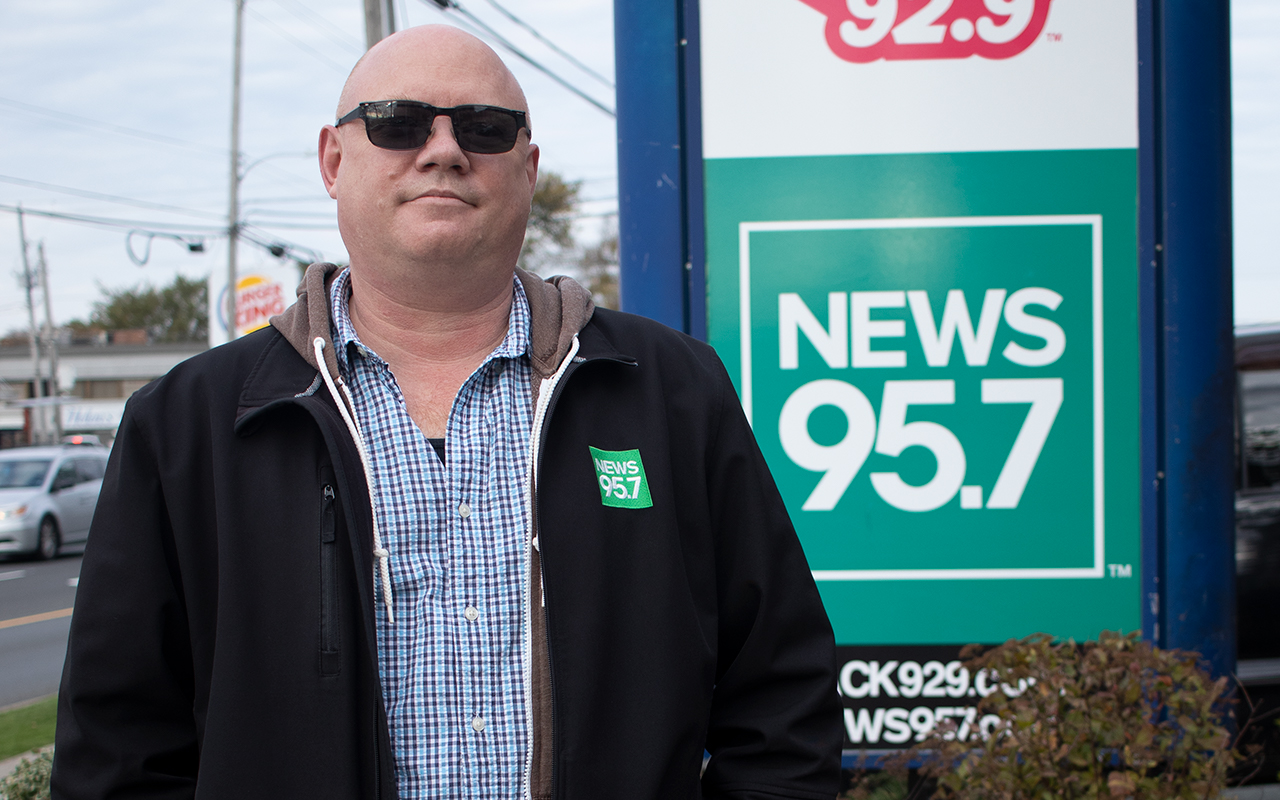Talk about trouble

caption
A microphone is surrounded by fire in this photo illustration.News/talk radio stations face possible closures
Just after 8 a.m., Sheldon MacLeod leaves home, armed with his coffee, for the 75-minute commute to the News 95.7 office in Halifax. As he drives he sips, flipping through radio channels, getting abreast of the day’s top stories. He enters the office after nine and gets straight to work. His goal: finding out what’s happened, to whom, and why it’s important.
MacLeod has worked in radio for more than two decades. For the last seven years he’s hosted The Sheldon MacLeod Show, a three-hour talk show on Nova Scotia’s only news/talk station.
“I’ve got a front row seat,” he says, “on this experience called life.”
Since 2000, Canadians over the age of 18 have been listening to less traditional radio. The rise of the Internet has offered listeners a more customizable way to get news and information. When those moved online, so did advertising. News/talk radio revenue has been slowly, steadily declining since 2014, according to the Canadian Radio-Television and Telecommunications Commission’s Communications Monitoring Reports.
Then: coronavirus.
Businesses of all kinds closed during the pandemic. Costs needed to be cut. In the radio business ad revenue plummeted, leaving news/talk radio gasping. If government doesn’t intervene, commercial radio stations could face widespread closures.

caption
Sheldon MacLeod in front of News 95.7 in Halifax.Community impact
MacLeod spends the first three hours of his day sending flurries of emails, phone calls and social media DMs, booking guests. If he’s lucky, he has time to squeeze in a peanut butter and banana wrap while he researches. For every hour he’s on air, he spends at least an hour preparing. At 12:30 p.m. he goes live. He’s on air every weekday until 3:30 p.m., bringing context, facts and voices to stories affecting Nova Scotia.
Despite facing challenges, local news/talk radio remains a fierce competitor among the growing news landscape.
“News/talk radio has that sense of immediacy,” says Alfred Hermida, Director of the University of British Columbia’s School of Journalism. “One of the beauties of radio is you can have it on in the background. It becomes your companion to your morning routine. Or it becomes your companion on your commute.”
While Hermida doesn’t think news/talk radio will disappear, he believes it may continue to shrink. Traditional news/talk radio stations get most of their revenue from advertising. For nearly 90 years, this model worked. The Internet changed that.
By 2013 news/talk radio’s advertising revenue started dropping. From 2014 to 2018, it dropped 5.8 per cent. Revenue for commercial radio as a whole fell 6.7 per cent between 2013 and 2018.
The Canadian Association of Broadcasters expects commercial radio advertising revenues to be $383 million less in 2020 than in 2019. More than 40 per cent of private radio stations in Canada were already facing losses in 2019.
In August 2020 the CAB released a report, The Crisis in Canadian Media and the Future of Local Broadcasting. It predicted that 50 of Canada’s 737 commercial radio stations may close by the end of 2020 – about three per week. Another 150-200 could go silent in the following 18 months.
Steve Jones, Senior Vice-President of Stingray Radio, a radio group based in Toronto, believes these predictions haven’t come true yet because companies are using income from music stations to fund news/talk stations.
The other thing keeping radio stations alive, he says, is “hope.” “They’re waiting on a CRTC review of radio regulations, or they’re waiting on regulatory relief that can help create a new structure to ease the pain they’re facing right now.”
Local advertising revenues for private news/talk radio stations Source: Statistics Canada
Filling the gaps
Where commercial news/talk radio isn’t providing local coverage, another format is filling the gaps: community radio. Driven by retired broadcasters, new journalists and concerned citizens, community radio covers local news where commercial radio has abandoned the market or moved to regional coverage.
There are approximately 180 campus and community radio stations in Canada. According to the National Campus and Community Radio Association (NCRA), about one-fifth of Canadians listen to community radio.
County FM is one of three broadcasters on the air in Prince Edward County in southeastern Ontario. The other two broadcasters, 26 kms away in Bellville and 38 kms away in Trenton, focus on regional coverage, leaving Prince Edward County without local news coverage.
Craig Foster, News Director at County FM, knows commercial news/talk radio leaves gaps.
Just weeks before COVID-19 into slammed Ontario early in 2020, County FM was approved for a Community Radio Fund grant. The money would be spent developing an emergency plan outlining the station’s role in the community during a crisis. “We were mapping out emergency planning,” Foster says, “and we have one land literally in our laps.”
He wasn’t worried about the station’s financial future. He had too much else to do. He’s one of the station’s only staff members – it normally relies on a network of more than 100 community volunteers.
According to Foster, one of the challenges with community radio is sometimes you’re working with “flat-out amateurs.” Being a seasoned journalist, he took over every newscast the station aired for the first two weeks of the pandemic. They couldn’t risk getting this wrong.
For those two weeks he barely lifted his head from his computer as he sifted through information, scrambling to get public health updates out to Prince Edward County.
Commercial radio advertising revenues, 2015-2019 and predicted revenue for 2020. Source: Statistics Canada, Canadian Association of Broadcasters
Regulatory relief
A number of COVID-19 relief measures were rolled out to Canadian broadcasters in the first half of 2020, including $11 million to private independent radio stations. The CAB on July 13, 2020 filed an application for more COVID-19 relief to the CRTC, asking that the nation’s broadcasters be granted some regulatory relief.
One of the broadcasters’ obligations is to contribute to the Canadian Content Development fund. Broadcasters have to give a percentage of the previous year’s revenue to the fund, which distributes the money to various initiatives, including the national Community Radio Fund of Canada. The Community Radio Fund in turn has filed a comment with the CRTC, saying that releasing commercial broadcasters from regulatory obligations would further damage local news coverage.
Barry Rooke, Executive Director of the National Campus and Community Radio Association, is worried. Community radio stations in Canada reported losses of $8 million in 2020. Further losses of funding could mean stations closing.
Without community radio to fill the gaps, Rooke fears people may be misinformed by the Internet. “They become part of these fractured communities that lose a sense of belonging,” he says.
In 2018, the Department of Canadian Heritage appointed an independent panel to review the Canadian Broadcasting Act and make recommendations to modernize it for the digital age. Public forums were held across Canada to listen to what broadcasters, Internet providers, and Canadians wanted reflected in the new legislation.
The final report was released in January 2020. Not a moment too soon.
It made sweeping recommendations, including emphasizing the need for international online platforms – like Spotify and YouTube – to contribute their fair share to the Canadian market from which they benefit. As well, it recommended reducing barriers to Internet access for Canadians and requiring sites like Facebook, which allow sharing of news articles, to compensate news creators. It also recommended levying sales tax on media giants like Apple Podcasts, levelling the financial playing field for Canadian media. Another recommendation was the introduction of liability legislation for harmful content spread online.
Broadcasters hoped these recommendations would be tabled before the House of Commons in June 2020. That didn’t happen. They now hope that moving these recommendations into law will happen soon. The longer it takes to get these recommendations in front of the House of Commons, the harder hit news/talk radio will be.
Holding out hope
Back at the News 95.7 Office, MacLeod wraps up after a busy day. The last thing he does before heading home is record a promo for the next morning’s show.
Despite the challenges facing news/talk radio, he remains optimistic.
“One of the beautiful things about radio is that television was supposed to kill it – it didn’t. Internet was supposed to kill it – it didn’t,” he says. “There’s always a need for stories, for human stories. And there’s nothing more powerful than me speaking to you directly.”
Editor's Note
Turmoil in the private radio industry continues. The week before this story was published, changes at News 95.7 in Halifax included cancelling The Sheldon MacLeod Show.

